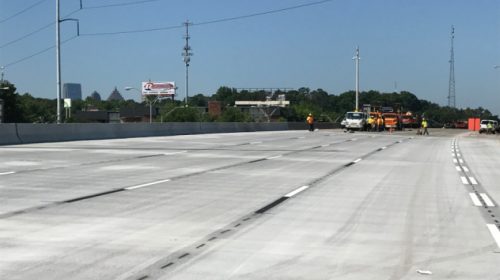The Georgia Department of Transportation approved the use of Premier Construction Products Group’s PREVent-C, a shrinkage-reducing and crack control admixture, among accelerated construction techniques on the Interstate 85 over Piedmont Road Bridges contract. Completed ahead of schedule, the six-week emergency project stemmed from a late-March fire that doomed twin structures carrying upwards of 250,000 vehicles daily.
|
|
| Georgia DOT observed PREVent-C mixes’ shrinkage and crack control properties on three bridge repair and check template maintenance projects prior to the Interstate 85 over Piedmont Bridges contract, where the admixture was specified for deck and barrier concrete. |
 |
A fixture in Atlanta ready mixed production, Thomas Concrete added PREVent-C to bridge deck and barrier mixes to ensure an efficient construction timeline and low maintenance, finished structure. The admixture was selected because it blends expansive components with pore water surface tension reduction to defend against cracks and increase a structure’s projected service life. It has been proven to reduce concrete shrinkage by more than 90 percent, Premier CPG reports, depending on mix design and PREVent-C dosage.
The product yielded a positive effect for GDOT and had no adverse effect on the concrete production and finishing process, notes Thomas Concrete Director of Technical Services John Cook. Crews from lead contractor C.W. Mathews Contracting Co. noticed no difference in working with the PREVent-C mixes versus standard bridge concrete, adds Vice President of Structures Adam Grist, who commends state officials for embracing innovative concrete technologies.
“Bridge durability [is] severely compromised by shrinkage cracks, which occur due to volume change caused by the drying process as well as other mechanisms,” observes Premier CPG Vice President of Sales Jim Preskenis. “PREVent-C is used on any crack-critical structure or whenever there are shrinkage concerns. In a typical scenario when accelerated strength and minimal curing are used, cracking would be visible immediately following the end of curing. On I-85 when the curing was removed, no cracking was observed.” — Premier Construction Products Group, Waynesville, N.C., www.premiermagnesia.com/cpg
